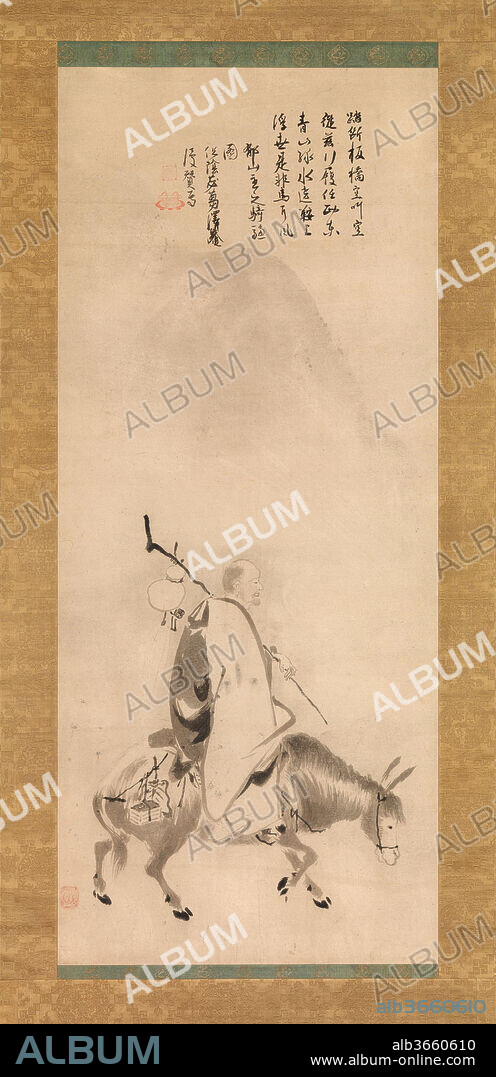alb3660610
KANO NAIZEN, INSCRIBED BY TAKUAN SOHO. Zheng Huangniu and Yushanzhu

|
Add to another lightbox |
|
Add to another lightbox |



Buy this image.
Select the use:

Title:
Zheng Huangniu and Yushanzhu
Caption:
Zheng Huangniu and Yushanzhu. Artist: Kano Naizen (Japanese, 1570-1616); Inscribed by Takuan Soho (1573-1645). Culture: Japan. Dimensions: Image (a): 44 in. × 18 11/16 in. (111.7 × 47.4 cm)
Overall with mounting (a): 78 11/16 × 24 5/8 in. (199.8 × 62.6 cm)
Overall with knobs (a): 78 11/16 × 26 9/16 in. (199.8 × 67.5 cm)
Image (b): 44 1/16 × 18 11/16 in. (111.9 × 47.4 cm)
Overall with mounting (b): 78 15/16 × 24 1/2 in. (200.5 × 62.3 cm)
Overall with knobs (b): 78 15/16 × 26 9/16 in. (200.5 × 67.4 cm). Date: early 17th century.
Zheng Huangniu, at right, and Yushanzhu, at left, were two legendary Chinese Chan (Japanese: Zen) monks often paired in Japanese painting beginning in the early Muromachi period. Zheng Huangniu (Japanese: Seiogyu), whose name means "Zheng of the Yellow Ox," is known for riding a yellow ox to which he attached various objects, such as water jars and books. As is common in later Japanese examples, here Zheng rides his ox backwards. Yushanzhu (Japanese: Ikuzanshu, "Master of Mount Yu") is said to have gained enlightenment when he fell off his donkey while riding across a bridge.
The poetic inscriptions, rendered in a crisp and brusquely brushed style, are by Takuan Soho, one of the most influential Zen monks of his day.
Right scroll:
A man of the Way
sits at ease, without a care,
astride a yellow ox, detached
from the wind and dust of the world.
He has left the hermitage
of his garden,
and from the ox's horn hangs a sprig
of peony from the Yao or Wei.
Casually inscribed by the recluse monk
Nanzan Takuan.
Left scroll:
Having crossed the plank bridge again,
seeking emptiness in vain,
I embark on a journey
with no destination in mind.
Blue mountains and green waters
surround the mounted traveler,
as the rights and wrongs in the transient world
breeze past the horse's ears.
Painting of the Master of Mount Yu Riding a
Donkey, casually inscribed by
Sokuin Hissu Takuan
--Trans. Shi-yee Liu.
Technique/material:
Pair of hanging scrolls; ink on paper
Period:
Momoyama period (1573-1615)
Museum:
Metropolitan Museum of Art, New York, USA
Credit:
Album / Metropolitan Museum of Art, NY
Releases:
Model: No - Property: No
Rights questions?
Rights questions?
Image size:
2034 x 4200 px | 24.4 MB
Print size:
17.2 x 35.6 cm | 6.8 x 14.0 in (300 dpi)
 Pinterest
Pinterest Twitter
Twitter Facebook
Facebook Copy link
Copy link Email
Email
